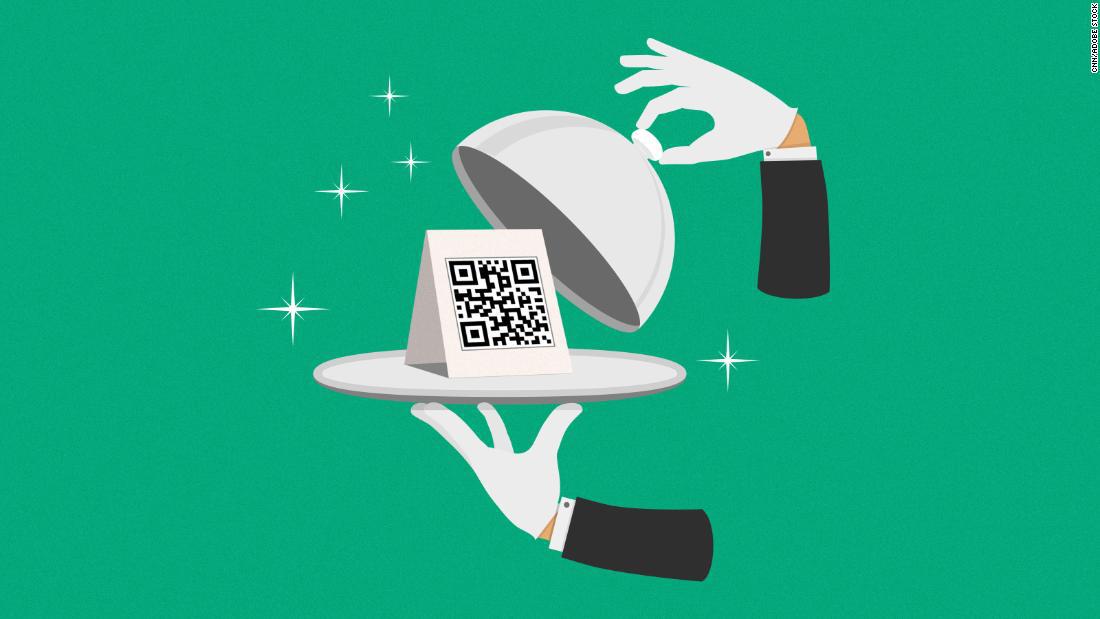Restaurants fear inflation will force them to close 1:06
New York (CNN) -
Restaurant menus have been revamped thanks to covid-19: now, to place an order, just take out the phone and scan a quick response code or QR, for its acronym in English.
QR codes are all the rage, but the technology behind them is not new.
They were invented in Japan in the 1990s as a kind of barcode that supplies information to digital devices and arrived in the United States about a decade later.
But the technology fell short of projections that it would revolutionize the consumer experience.
However, the needs related to the pandemic have skyrocketed the popularity of the codes, becoming another example of how the pandemic has turned all kinds of businesses upside down.
The return of the QR code
Tens of thousands of restaurants closed as of spring 2020, some permanently, in response to COVID-19 restrictions and physical distancing guidelines.
People around the world were reluctant to go out to eat, fearful of contracting the virus.
The fear of bars and restaurants for possible new restrictions
Many restaurants found offering single-use menus expensive and unsustainable, and some customers were unwilling to touch them.
advertising
This is how QR codes came onto the scene.
"It wasn't so long ago that QR codes were an archaic technology that was laughable," Aaron Allen, global restaurant consultant, tells CNN Business.
Now, QR code companies are reaping the rewards, thanks to an influx of money from food companies in the last year, according to him.
It is also popular from an environmental perspective.
"There's always paper being thrown away," as menus are updated so frequently, explains Tim Wekezer, CEO of Waitrr, a contactless mobile ordering company for restaurants.
The digital menus seen on smartphones do not require plastic covers or storage.
QR code technology allows restaurants a smoother update process;
a change in the menu can be managed with an online update.
China is fighting the coronavirus with a digital QR code.
That's how it works
Restaurant reactions
Some restaurants are beginning to reintroduce physical single-use menus as more people get vaccinated and become more comfortable eating at restaurants again.
But many owners say that QR codes have improved the dining experience for their customers.
The Bartaco restaurant chain, with 22 locations across the US, refers to its implementation of the QR code as "à la carte hospitality," said the company's CEO Scott Lawton.
"Being able to dictate your own experience has been a great convenience for clients," he said.
Customers can pull out their phones and scroll through the menus.
"It's going to be a preference for many customers, especially when it comes to an interactive menu that makes it easy to find options related to diet and allergies," said Rom Krupp, CEO and founder of hospitality technology company OneDine.
If you are not vaccinated against covid-19, you should not go to a bar or restaurant, says an expert
Motel Morris, a New York restaurant serving what it describes as "contemporary American cuisine," ditched the conventional menus and has been using QR codes since it reopened in August 2020. Now its owner Sam Nidel is experimenting with the gradual introduction of physical menus again, mainly for older diners who are more comfortable with them.
But QR codes stick around, and he's prepared to rely solely on QR codes if covid-19 rates continue to rise.
The future of menus
Waitrr, a take-out and take-out ordering app, launched its menu app in 2015 and was worth $ 4.5 million in December 2019. Now, the Singapore-based company is worth nearly $ 4.5 million. triple, and sales are up 544% despite closures in some of Waitrr's main markets in Europe and Asia, Wekezer said.
"Normally, our service costs the same or is cheaper than the credit card terminal. It is an easy decision for the restaurant," he said.
For hospitality company OneDine, whose point-of-sale software includes contactless ordering and payment, "having this technology ready when the pandemic hit helped our business grow very quickly," Krupp said.
OneDine currently works with more than 1,000 restaurants, most in the US and a few in the UK, but Krupp said it expects that number to double in the next four months.
Krupp is aware that diners will take time to adjust.
"There will be a percentage of customers who are not yet comfortable with the digital experience and prefer a physical menu," Krupp said, noting that many travelers still prefer to check-in at the airport counter than through their smartphones or at line.
QR CodeRestaurants

